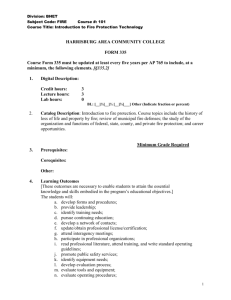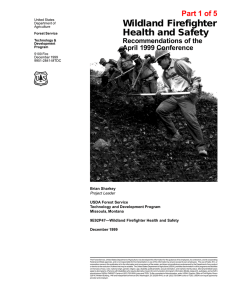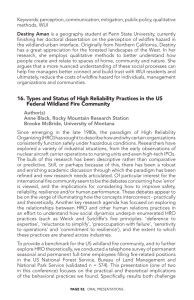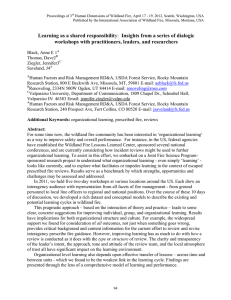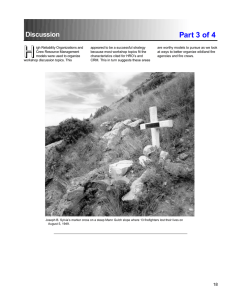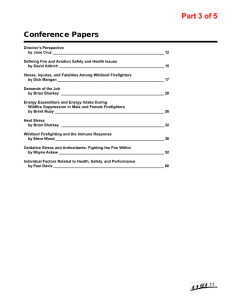Findings From the Wildland Firefighters Human Factors Workshop
advertisement
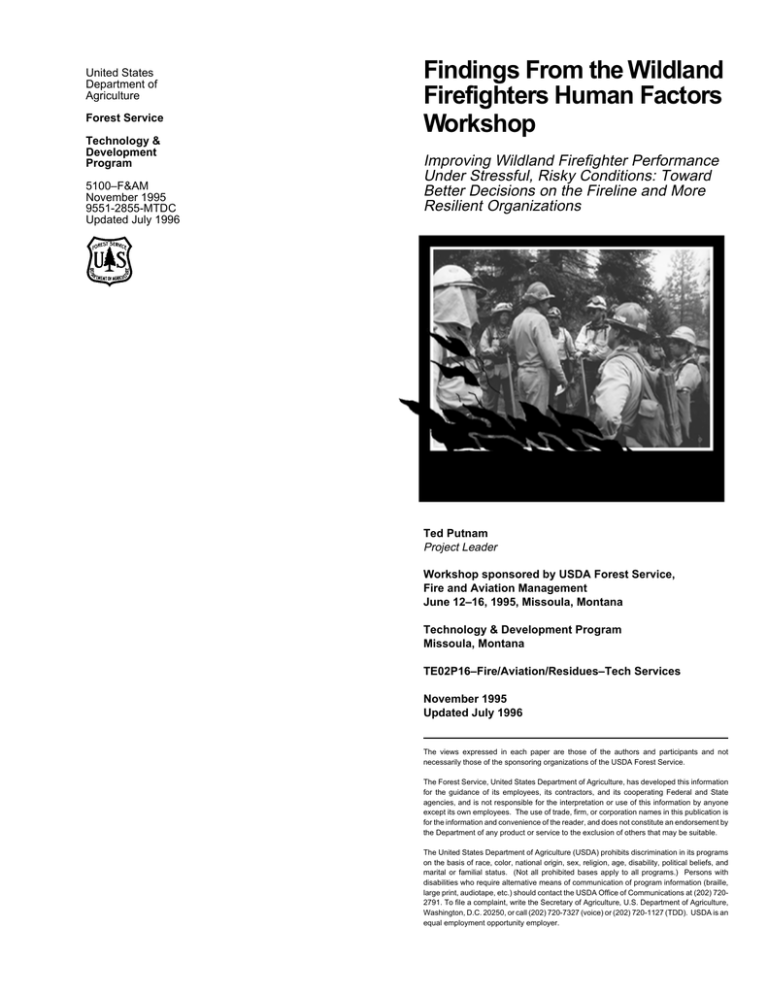
United States Department of Agriculture Forest Service Technology & Development Program 5100–F&AM November 1995 9551-2855-MTDC Updated July 1996 Findings From the Wildland Firefighters Human Factors Workshop Improving Wildland Firefighter Performance Under Stressful, Risky Conditions: Toward Better Decisions on the Fireline and More Resilient Organizations Ted Putnam Project Leader Workshop sponsored by USDA Forest Service, Fire and Aviation Management June 12–16, 1995, Missoula, Montana Technology & Development Program Missoula, Montana TE02P16–Fire/Aviation/Residues–Tech Services November 1995 Updated July 1996 The views expressed in each paper are those of the authors and participants and not necessarily those of the sponsoring organizations of the USDA Forest Service. The Forest Service, United States Department of Agriculture, has developed this information for the guidance of its employees, its contractors, and its cooperating Federal and State agencies, and is not responsible for the interpretation or use of this information by anyone except its own employees. The use of trade, firm, or corporation names in this publication is for the information and convenience of the reader, and does not constitute an endorsement by the Department of any product or service to the exclusion of others that may be suitable. The United States Department of Agriculture (USDA) prohibits discrimination in its programs on the basis of race, color, national origin, sex, religion, age, disability, political beliefs, and marital or familial status. (Not all prohibited bases apply to all programs.) Persons with disabilities who require alternative means of communication of program information (braille, large print, audiotape, etc.) should contact the USDA Office of Communications at (202) 7202791. To file a complaint, write the Secretary of Agriculture, U.S. Department of Agriculture, Washington, D.C. 20250, or call (202) 720-7327 (voice) or (202) 720-1127 (TDD). USDA is an equal employment opportunity employer. Part 1 of 4 Contents Part 1 of 4 Background _____________________________________ 3 Part 2 of 4 Workshop Overview ______________________________ 4 The Start _____________________________________________ High Reliability Organizations: A Vision for Fire Reorganization ___________________________________ Using the Crew Resource Management Model in Fire __________ Assessment and Feedback _______________________________ 4 5 6 7 Workshop Findings ______________________________ 8 Fire Organization and Culture _____________________________ 8 Fire Management, Incident Management Teams, and Fire Crews in a Crew Resource Management Context _______ 10 Assessment and Feedback ______________________________ 16 Part 3 of 4 Discussion _____________________________________ 18 Recommendations ______________________________ 19 A Final Note ____________________________________ 21 References _____________________________________ 22 Part 4 of 4 Appendix A—Overview __________________________ 23 Appendix B—Agenda ____________________________ 24 Appendix C—Participants ________________________ 26 Appendix D—Keynote Presentations _______________ 30 Addressing the Common Behavioral Element in Accidents and Incidents _______________________________ Naturalistic Decision Making and Wildland Firefighting ________ Cultural Attitudes and Change in High-Stress, High-Speed Teams ___________________________________ South Canyon Revisited: Lessons from High Reliability Organizations _______________________________________ 30 33 36 42 Appendix E—Related Reports _____________________ 54 The Collapse of Decisionmaking and Organizational Structure on Storm King Mountain _______________________ 54 The Collapse of Decisionmaking and Organizations: The Mann Gulch Disaster ______________________________ 59 2 Background I t has become increasingly clear that wildland firefighters are experiencing collapses in decisionmaking and organizational structure when conditions on the fireline become life-threatening. Since 1990 wildland fire agencies have lost 23 Part 1 of 4 people who might have survived had they simply dropped their tools and equipment for greater speed escaping fires. We are averaging more than 30 entrapments each year now. And during the 1994 fire season, 34 people died, 14 on the South Canyon Fire alone. These facts tell us that firefighting organizations, crews, and individuals need to be much more proficient at decisionmaking under stressful, risky conditions. Improving proficiency will require new training and attitude changes. And this in turn requires a thorough examination of the human dimensions of wildland firefighting. This examination is not limited to firefighting crews and teams (i.e., smokechasers, engines, helitack, incident management, type I, and type II) but extends to fire management officers, dispatchers, fire support, managers with fire and resource responsibilities, up to Agency heads. These people encompass a fire community. Fire community implies an awareness that we are interconnected and interdependent and should approach firefighting from the point of view that we are all in this together. To begin to address some of the human factors questions, experts in psychology, sociology, organizations, fire safety, and wildland firefighting attended a 5-day workshop in June 1995 to discuss ways of improving firefighter safety. Workshop participants explored firefighter psychology, interactions among firefighters and among fire crews, and better ways to organize. After several days of discussions, they developed a series of recommendations for beginning to implement changes that would improve the fire organization and firefighter safety. This paper outlines the workshop’s findings and recommendations. The workshop represents a first step in what will be a long journey toward a better understanding of the human side of wildland firefighting. Ted Putnam Workshop Organizer The main entrapment site at the South Canyon Fire where 12 firefighters lost their lives on July 6, 1994. -End Part 1- 3

